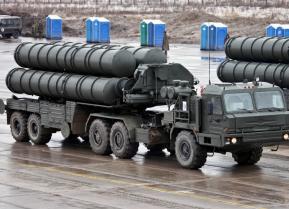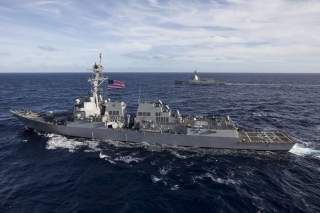How the U.S. Navy Forgot to Fight
The U.S. Navy is suffering from self-inflicted strategic dysfunction across the breadth of its enterprise.
Regardless of where they stand in relation to one another on the continuum of military excellence it appears the Chinese Sailor is learning and becoming a more lethal professional at a rate that far outstrips his American rival.
Training and Satisfaction in the Profession of Arms
“If we fight our fleets in mimic fights against each other, every officer and seaman, and fireman, and ward-room boy will understand enough to become interested. What we need more than anything else is to make our people interested…certainly no profession gives the opportunities for continued interest that ours does…yet is there anything more heartbreaking in its dullness than a man-of-war is often made to be!” –Commander Bradley A. Fiske, “American Naval Policy,” 1905.
A key distinction between institutions that provide security and most other organizations is that they rarely get to apply the full scope of their potential until an immediate threat demands a response. Most other organizations operate under a steady grind where they regularly apply foundational skills and often in direct competition against many others who are doing the same. Until an imminent threat appears an organization focused on security must remain in a self-imposed state of vigilance. This comes with unique challenges of promoting professional satisfaction and morale.
Being a sentry, as important as that may be, is hardly gratifying. The logic of promoting deterrence is often not tangible enough to be professionally fulfilling on its own to most who wear the uniform. After spending an ungodly amount of time filing paperwork, attending sessions, and conducting so many other preparations warfighters crave the opportunity to do their job and put their skills to the test. An organization focused on security should conduct hard training not only for the sake of preparedness but to give its people opportunities to push their limits and enjoy the fulfillment of becoming a better professional. In the absence of a pressing mission that demands the immediate use of specialized skills a focus on growing those skills is the next best thing.
While the Navy featured prominently at the opening of many campaigns and saved lives in humanitarian disaster the emphasis on low-end missions and training hardly helped Sailors experience the full potential of the powerful Navy they joined. The power projection era precluded Sailors from practicing many of the core high-end missions and skills a superpower Navy is usually built for, yet Sailors were still responsible for the extensive maintenance that high-end capability required. Scripted training under the bloated certification system has turned most tactical training into just another chore on a checklist rather than a stimulating exercise that focuses on quality learning and professional development.
The professional development opportunities that come with joining the most powerful Navy should be especially unique. In how many places can someone practice warfighting skills and operations using some of the most advanced warships ever made? How many jobs allow someone to become the best in the world at taking command of the seas through skill of arms? Surely there is some connection between the level of opportunity to grow as a better warfighter through hard trials and the unique job satisfaction that comes with being a military professional. Has the Navy harmed retention and morale by letting too many requirements, inspections, and low-end missions crowd out time for hard training? Clearly people joining the Navy would much rather be “forged by the sea” instead of forged by their inbox.
Training and Human Capital in the Profession of Arms
“…I would argue that nothing takes precedence over the peacetime commander’s job of finding combat leaders.” –Captain Wayne P. Hughes, Jr. (ret.), Fleet Tactics, Theory and Practice
The training certification system is unable to maintain a consistent standard across the force because luck plays an important role in how well the American Sailor gets trained. The fixed nature of the workup cycle and the variety of deployment experience create a roulette wheel of training opportunity. A Sailor can report to a ship only to spend the entirety of their assignment stuck in drydock with limited operating time. A Sailor that happens to report aboard closer to a deployment will have far more opportunity to conduct at sea operations, especially integrated training within a larger group of ships. One Sailor can deploy to mainly exercise with numerous third world navies while another’s deployment can feature exercises with more capable allies. The nature of the workup cycle and the variety of overseas experience sends a hodgepodge of training experience throughout the Navy’s ranks. This creates the need for major training events that are disconnected from the deployment cycle to better standardize proficiency. By the time a combat arms leader becomes a general officer in the Army or Air Force they have usually paid multiple visits to Red Flag and the National Training Center across their career.
While machines reflect learning as they grow in capability corporate memory is mainly carried forward by people. In this respect the Navy’s wholesale shift toward power projection not only inhibited its ability to practice war well, but failed to preserve a responsible minimum of institutional memory for full-spectrum competence. As Cold War-era personnel retired and separated from the service the Navy hemorrhaged skills and experience born from a time of better warfighting standards. Those with Cold-War era experience who still serve today saw their tactical skills atrophy under a new strategic focus. The result is that on average American Sailors know far less about high-end combat and sea control than they did 30 years ago. An organization that often describes its training in terms of “reps and sets” should have also understood the concept of use it or lose it.
American Sailors can put their training into a different “reps and sets” context. How many times have they run the exact same scenarios? How many times have they seen a live opposing force defeat a strike group? Are scripted exercises the defining training experience of a generation of American Sailors? In a system where everyone gets a trophy it is hard to know who is any good.
But training should not always be about winning or passing a test. Training is supposed to be a learning experience where failure is welcomed as an opportunity to learn and further prove oneself. Scripted training inhibits arguably the most important part of the training process – the after-action review. In the after-action review troops are expected to confront their mistakes, reflect upon alternatives, and contemplate their thought process. Without failure or the fear of future failure there will be less to question and reflect on. A solid after-action review process is necessary to give people a space where they can distinguish themselves as learners.
The after-action review of a training exercise can be a most humbling experience for the military professional where leaders are forced to take responsibility for mistakes that would have gotten their people killed in war. How a leader accounts for such consequential errors can reveal something about their command philosophy and leadership style. There is also a large difference in taking responsibility for failure within view of hundreds if not thousands of participating Sailors after a live exercise versus a virtual wargame that is played in the company of only a handful of fellow officers. The highly concentrated nature of modern naval capability and authority has given the enlisted Sailor virtually no ability to shape his or her fate through tactics in high-end war at sea. It is on the ship’s officers to know how to fight well for the sake of everyone else aboard.
Scripted exercises inhibit the warfighter’s ability to develop the unique professional skills critical to success on the battlefield. These special skills can range from employing warfighting techniques and tactics, maintaining unit cohesion while taking heavy losses, and knowing how to gamble with equipment and lives. Skillfully managing the chaos of war favors certain personal qualities such as the utmost candor, open-minded thinking, and a willingness to push to failure. These traits hardly describe the character of heavily scripted training. Without hard combat trials one cannot prove skill and virtue in ways only a warfighter can.
What scripted exercising has done to the Navy is damage its ability to discover those within its ranks who best exemplify the profession of arms.
Rudderless
“After their examination, the recruits should then receive the military mark, and be taught the use of their arms by constant and daily exercise. But this essential custom has been abolished by the relaxation introduced by a long peace. We cannot now expect to find a man to teach what he never learned…” –Vegetius, De re militari
If the most important peacetime military mission is to realistically prepare for war then what happens if this primary mission does not act to unify effort across the enterprise? Compared to all other peacetime operations exercises are the activity that come closest to real war which makes them an indispensable foundation for force development. Realistic exercising is what best integrates and filters the vital functions that evolve training, tactics, and doctrine. Exercises are also some of the best means for investigating the changing character of future war as technology evolves. The lack of realistic exercising is much more than an issue of questionable operator skill. It is a broader developmental problem for how the Navy is deciding its future.


